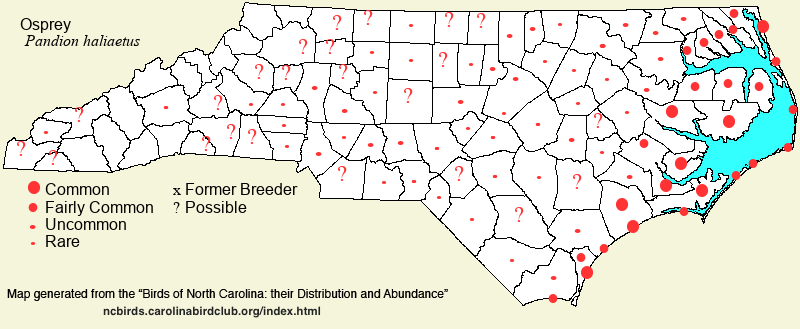 |  |
|
Osprey - Pandion haliaetus Sole representative of PANDIONIDAE in NC | Search Common: Search Scientific: |
|
|
|||||||
| General Comments | The Osprey is one of the more familiar birds of prey to the layman, easily identified near the coast and at lakes as it plunges into water for fish. Ospreys were common coastal breeders (but not far inland) at least into the 1960's, but DDT was a prime culprit in its decline as a breeder in the state for about 15 years. Since about 1980, numbers have returned to normal in coastal areas, and because of reservoir construction and an increase in beaver ponds, Ospreys have begun to nest at scattered sites throughout the Coastal Plain and Piedmont, but apparently not yet in the mountains. And, because of warmer winters in recent years, more Ospreys linger into winter, with some overwintering along the southern coast. This species is always found around water, the larger the water body the better. It is most common along the coast, foraging in sounds, bays, and even in the near-shore ocean. Away from the coast, it is most frequent at reservoirs, but it occurs at large millponds, along rivers, and even at large farm ponds. | ||||||
| Breeding Status | Breeder | ||||||
| NC BRC List | Definitive | ||||||
| State Status | |||||||
| U.S. Status | |||||||
| State Rank | S4B,S1N | ||||||
| Global Rank | G5 | ||||||
| Coastal Plain | Summer resident and migrant, and sparse winter visitor/resident. Fairly common to common (for a large raptor) along the coast and in the Tidewater zone, more frequent in the southern coastal areas and at local Tidewater sites; uncommon in early winter along the southern coast and rare farther north (including Tidewater), but rare to uncommon by late Jan; however, breeding birds start returning in Feb, so difficult to know how many birds actually overwinter. Farther inland, fairly common spring and fall migrant, and rare to uncommon and local breeder (can be numerous at a few sites such as Lake Ellis Simon); rare in early winter. Primarily late Feb or early Mar to Nov. Peak counts: | ||||||
| Piedmont | Primarily a transient, but also a local breeder. Fairly common in migration, more numerous in the eastern portion, and uncommon to fairly common in the western portion; rare to locally uncommon breeder, at reservoirs; rare in early winter, and very rare in Jan-Feb; does not overwinter in the province. Began nesting in the province around 1985; several pairs each nest at Falls, Jordan, and Norman lakes, and single pairs nest on other lakes. Peak counts: | ||||||
| Mountains | Transient, and extremely rare breeder. Generally uncommon, and mainly in lower elevations, below 3,000 feet. Though there are a number of large reservoirs in the province, especially in the southwestern counties (e.g., Fontana, Nantahala, Hiwassee), the species appeared to never have been reported to nest in the region until 2021, when adults and young were present at a nest on a utility pole at Santeetlah Lake (Graham) in Jun. A second nesting record was at Lake Julian Park (Buncombe), where a pair has nested in both 2024-25. Rare in early winter, and very rare in Jan-Feb. Peak counts: | ||||||
| Finding Tips |
Easily seen at coastal waters from about Mar into mid- or late fall. **** | ||||||
| Attribution | LeGrand[2025-10-22], LeGrand[2018-02-01], LeGrand[2012-05-15] | ||||||
| NC Map Map depicts all counties with a report (transient or resident) for the species. | Click on county for list of all known species. |
| NC Breeding Season Map Map depicts assumed breeding season abundance for the species. |  |